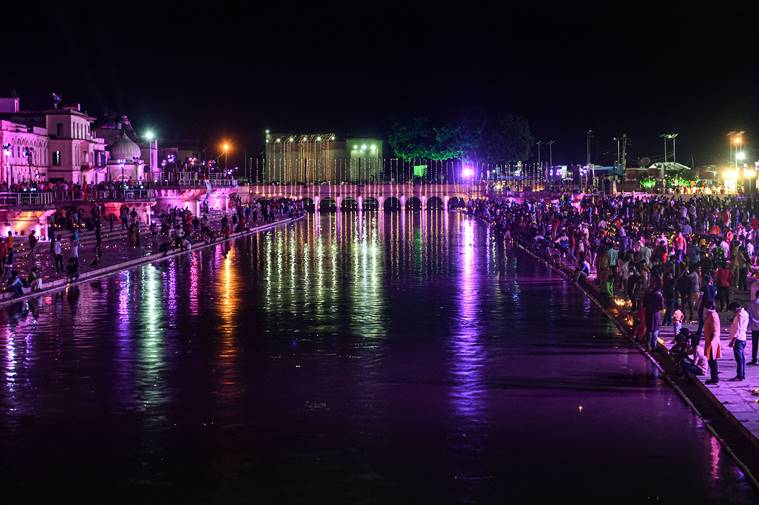 Prime Minister Narendra Modi and RSS chief Mohan Bhagwat in Ayodhya. (Photo: AP)
Prime Minister Narendra Modi and RSS chief Mohan Bhagwat in Ayodhya. (Photo: AP)
Building the Ram temple in Ayodhya was never a key election plank in either of Narendra Modi’s campaigns of 2014 and 2019 that delivered him two record wins. But when he laid the foundation stone for the temple Wednesday, the ceremony, both in form and content, marked him as the principal architect who has delivered on the BJP’s core ideological project.
Indeed, many in the Sangh Parivar, in private, attributed the BJP’s 2004 defeat to the “ideological compromises” made by Atal Bihari Vajpayee in the name of coalition politics. In contrast, Modi, on both Article 370 and the Ram temple, has, to the Sangh, underlined what electoral power can achieve and, in the process, reinforced his political credibility like no other leader in the BJP.
And this, largely on his own terms. Significantly, on the temple, Modi had resisted pressure from a section in the Sangh to bring in a law and, instead, had advised patience until the court verdict. When it came last November and that, too, as a 5-0 ruling effectively in favour of the temple, it was the perfect storm he needed – and was waiting for.
For a nation, where almost half of the population has been born after the demolition of the Babri Masjid, how effective the Ram temple will be as an issue today is open to debate.
Gone is the mass mobilisation of the late ’80s and ’90s and Hindutva has new layers and symbols now – the new citizenship law, for example.
This, perhaps, explains why Modi tried to frame the temple as a promise that had been delivered and as a symbol of “cultural liberation,” with a pan-Indian, even global, appeal than a project exclusively for the Hindu majority.
 Prime Minister Narendra Modi, third left, performs rituals during the groundbreaking ceremony of a temple in Ayodhya (AP)
Prime Minister Narendra Modi, third left, performs rituals during the groundbreaking ceremony of a temple in Ayodhya (AP)
That’s why he claimed that “support” extended to the temple came from all sections of society in the way they had responded to the call of Mahatma Gandhi during the freedom struggle. And said that social harmony lay at the heart of Lord Ram’s governance, the Ram Temple could be an instrument to unite the country.
“Ram is carved in our minds, he is within us. Whenever we want to do some work, we look up to Lord Ram for inspiration… There is hardly an aspect of life in which we can’t draw inspiration from Lord Ram. There’s no national sentiment that does not reflect his values. India’s faith has a reflection of Lord Ram, India’s ideals are a reflection of Him. Ram is in the faith of India, Ram is in the ideals of India. Ram is in the divinity and the philosophy of India,” Modi said.
Modi also used the occasion to link Ram to a pan-Indian ethos. “Ram sab ke hain, Ram sab mein hain(Ram is for everyone, in everyone),” he said. While the BJP’s Hindutva politics is criticised for its efforts to construct monolithic, uniform cultural norms, the Prime Minister invoked different linguistic versions – Tamil, Telugu, Malayalam, Odia, Kannada, Bengali among others – of the Ramayana to underline the manner in which Ram has been embraced by the plurality of Indian people.
 Devotees gather at illuminated Ram Ki Paidi to celebrate the groundbreaking ceremony of the Ram Temple, in Ayodhya (PTI Photo)
Devotees gather at illuminated Ram Ki Paidi to celebrate the groundbreaking ceremony of the Ram Temple, in Ayodhya (PTI Photo)
The optics of the participation of the head of Government in the Bhoomi Pujan, broadcast live on national TV, marks a direct repudiation of the Nehruvian ideal of the state – the first Prime Minister had objected to the presence of President Rajendra Prasad at the inauguration of the rebuilt Somnath temple believing that it contradicted the principle of separation of state and religion in secular India.
RSS chief Mohan Bhagwat recalled the roles played by L K Advani and Ashok Singhal in the movement. He also invoked the former sarsanghchalak, Balasaheb Deoras, to underline that it was a project undertaken by the RSS with a long horizon in mind.
📣 Express Explained is now on Telegram. Click here to join our channel (@ieexplained) and stay updated with the latest
Deoras, he said, had been prescient in suggesting that it would take 20-30 years to make the dream of the temple a reality. He described Wednesday’s ceremony as a beginning of a “glorious” India of the future – “param vaibhav sampann Bharat ke nirman ki shuruat”.
Bhagwat next to Modi, during the ceremony and on the dais when he spoke, clearly signalled the message to the Parivar: that the Sangh and the BJP-led Government at the Centre have worked together like never before – and have, therefore, delivered on their key ideological promise.